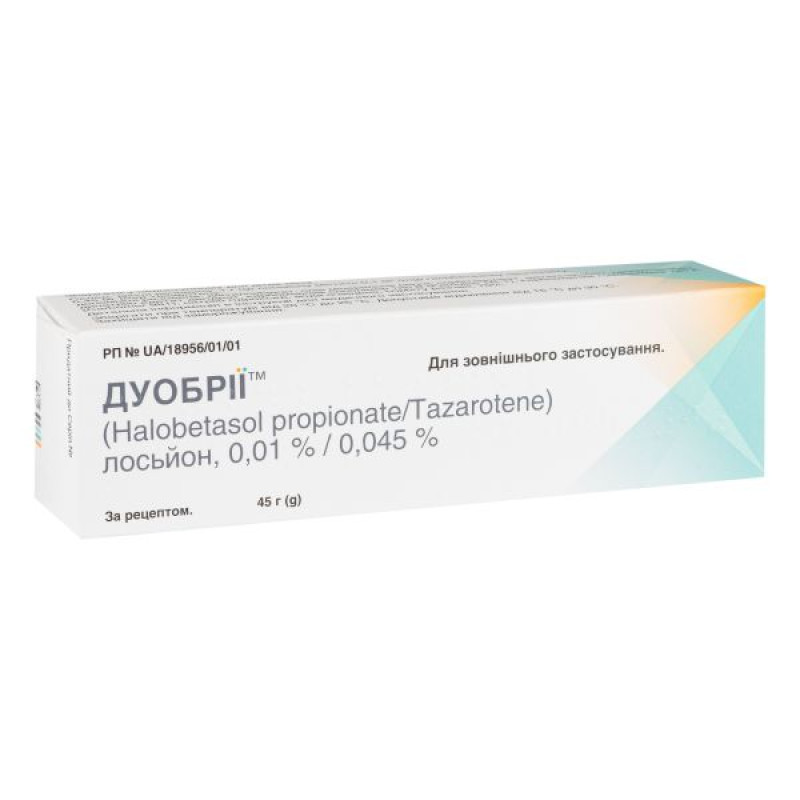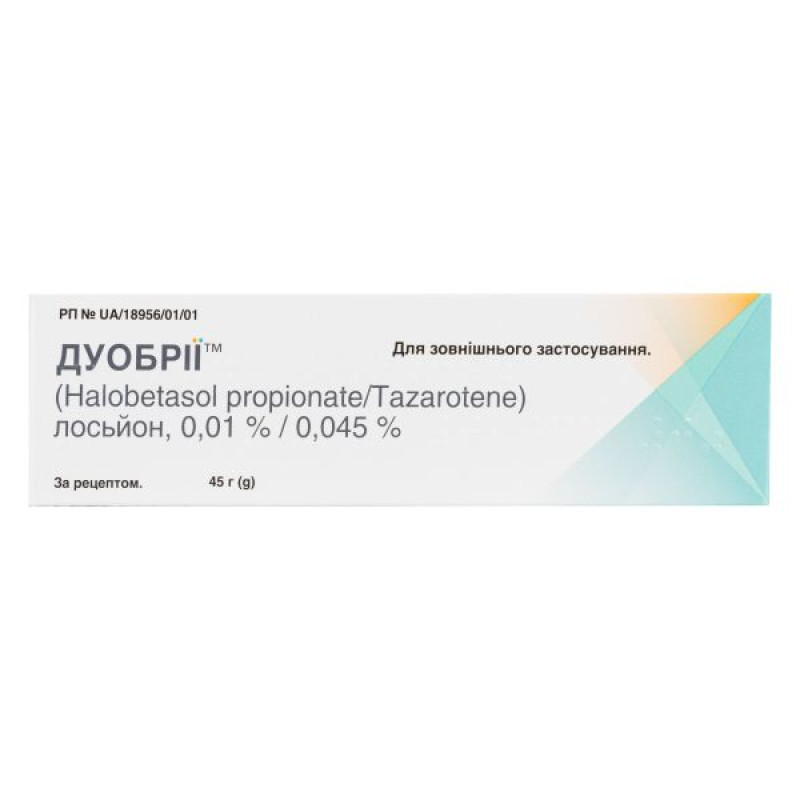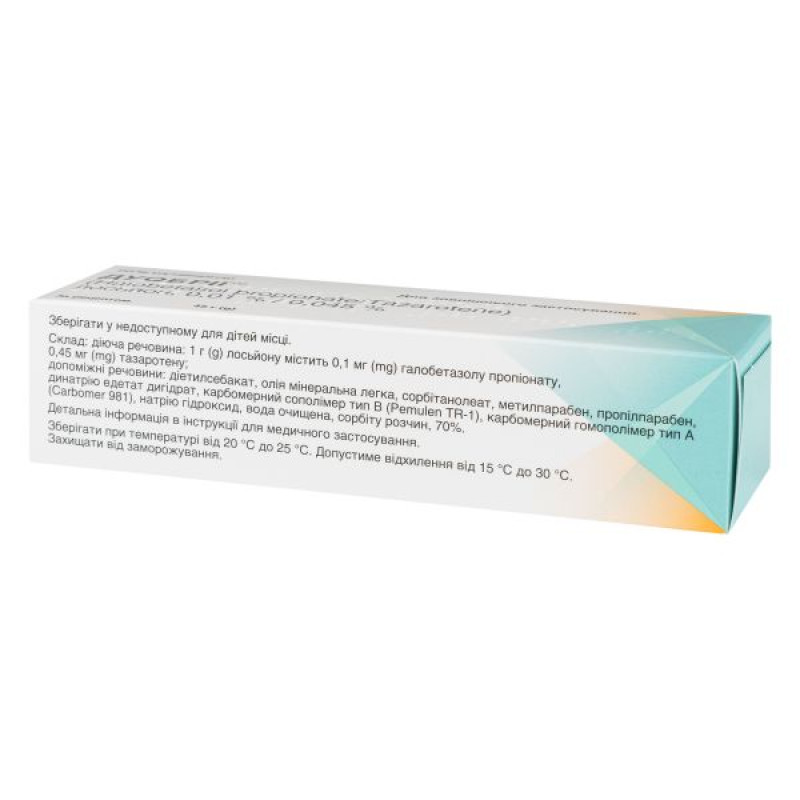Duobry lotion 0.01% + 0.045% tube 45 g

Instructions for use Duobrii lotion 0.01% + 0.045% tube 45 g
Composition
active ingredient: halobetasol propionate, tazarotene;
1 g of lotion contains halobetasol propionate - 0.1 mg, tazarotene - 0.45 mg;
excipients: diethyl sebacate, light mineral oil, sorbitan oleate, methylparaben, propylparaben, disodium edetate dihydrate, carbomer copolymer type B (Pemulen TR-1), carbomer homopolymer type A (Carbomer 981), sodium hydroxide, purified water, sorbitol solution, 70%.
Dosage form
Lotion.
Main physicochemical properties: white or almost white lotion.
Pharmacotherapeutic group
Antipsoriatic agents for topical use. Other antipsoriatic agents for topical use.
ATX code D05AX55.
Pharmacological properties
Mechanism of action.
Corticosteroids play a role in cell signaling, immune function, inflammation, and protein regulation; however, their exact mechanism of action in plaque psoriasis is unknown.
Tazarotene is a retinoid prodrug that is converted to its active form, tazarotenic acid, the carboxylic acid of tazarotene, by deesterification. Tazarotenic acid binds to all three members of the retinoic acid receptor (RAR) family: RARα, RARβ, and RARγ, but exhibits relative selectivity for RARβ and RARγ and may alter gene expression. The clinical significance of these findings for the 2-week treatment in Study 1 was not statistically significant.
Pharmacodynamics.
A vasoconstrictor study in healthy subjects using DUOBRIY™ Lotion showed that the drug is in the range of potent to superpotent activity compared to other topical corticosteroids. However, such performance does not necessarily imply therapeutic equivalence.
The potential for hypothalamic-pituitary-adrenal axis suppression was evaluated in a study of adults with moderate to severe plaque psoriasis. The average dose of DUOBRIA™ lotion was 8.2 grams, applied once daily for 8 weeks, and 20 participants were evaluated for hypothalamic-pituitary-adrenal axis suppression at weeks 4 and 8.
Hypothalamic-pituitary-adrenal axis suppression was observed in 3 of 20 (15%) participants at week 4. None of the 20 (0%) participants had hypothalamic-pituitary-adrenal axis suppression at week 8. In this study, the criterion for hypothalamic-pituitary-adrenal axis suppression was a serum cortisol level ≤18 μg/dL 30 minutes after stimulation with cosyntropin (adrenocorticotropic hormone).
The pharmacodynamics of tazarotene are unknown.
Pharmacokinetics.
After topical application, tazarotene undergoes esterase hydrolysis to form its active metabolite, tazarotenic acid.
Systemic exposure following topical application of DUOBRII Lotion was evaluated in the same study that evaluated suppression of hypothalamic-pituitary-adrenal axis suppression. This was an open-label, randomized pharmacokinetic (PK) study conducted in patients 18 years of age and older with moderate to severe plaque psoriasis involving at least 20% of the body surface area. The PK of halobetasol propionate, tazarotene, and tazarotenic acid were evaluated in 22 subjects after application of DUOBRII Lotion to the affected skin area once daily for 28 days. Systemic concentrations of halobetasol propionate (lower limit of quantification (LLOQ) = 50 μM/mL) and tazarotene (LLOQ = 5 μM/mL) on Day 28 were quantified in 13 and 18 of the total 22 subjects, respectively. Tazarotenic acid (LLOQ = 5 μM/mL) was quantified in all subjects. Systemic exposure to these three moieties was at steady state or near steady state by Day 28. The mean (SD) PK parameters at Day 28 are shown in Table 2.
Table 2: PK parameters of halobetasol propionate, tazarotene, and tazarotene
acids after a single administration of DUOBRII lotion for 28 days in patients with moderate to severe plaque psoriasis.
| Mean (standard deviation) (N=22) | ||||
| FC parameters | Halobetasol propionate | Tazarotene | Tazarotene acid | |
| Day 28 | Cmax (pg/mL) | 101.9(135.4) | 24.6 (27.3) | 523.4 (523.3) |
| AUC0–24 (pg*h/ml) | 1300 (1959) | 273 (403) | 9954 (10091 | |
Indication
Topical treatment of plaque psoriasis in adults.
Contraindication
Hypersensitivity to the active substance or to any of the excipients included in the medicinal product.
Diabetes.
Liver disease.
Adrenal gland disease.
Untreated skin infections.
Interaction with other medicinal products and other types of interactions
Not described.
Application features
Reversible suppression of the hypothalamic-pituitary-adrenal axis and other undesirable systemic glucocorticosteroid effects.
Systemic effects of topical corticosteroids may include reverse suppression of the hypothalamic-pituitary-adrenal axis with the possibility of glucocorticosteroid insufficiency. This may occur during or after treatment with topical corticosteroids.
The potential for hypothalamic-pituitary-adrenal axis suppression with DUOBRIA™ Lotion was evaluated in a study of 20 adult patients with moderate to severe plaque psoriasis involving ≥20% of their body surface area. Patients applied the product once daily for 8 weeks, after which hypothalamic-pituitary-adrenal axis suppression was assessed at weeks 4 and 8. Hypothalamic-pituitary-adrenal axis suppression was observed in 3 of 20 (15%) subjects at week 4, and none (0%) of these subjects had hypothalamic-pituitary-adrenal axis suppression at week 8.
Because of the potential for systemic absorption with topical corticosteroids, including DUOBRIY™ Lotion, patients should be periodically evaluated for evidence of hypothalamic-pituitary-adrenal axis suppression. Factors that predispose patients to hypothalamic-pituitary-adrenal axis suppression in patients receiving corticosteroids include use of more potent corticosteroids, application to large areas of skin, use under occlusive dressings, use in areas with compromised skin barrier function, concurrent use of multiple corticosteroid-containing products, hepatic impairment, and young age. An adrenocorticotropic hormone (ACTH) stimulation test may be useful in assessing the degree of hypothalamic-pituitary-adrenal axis suppression in patients.
If hypothalamic-pituitary-adrenal axis suppression is confirmed, the drug should be gradually discontinued by reducing the frequency of application. Manifestations of adrenal insufficiency may necessitate the use of additional systemic corticosteroids. Recovery of hypothalamic-pituitary-adrenal axis function usually occurs rapidly and completely after discontinuation of topical corticosteroids.
Systemic effects of topical corticosteroids may also include Cushing's syndrome, hyperglycemia, and glycosuria. Concurrent use of more than one corticosteroid-containing product may increase the total systemic exposure to corticosteroids.
Children, compared with adults, may be more susceptible to systemic side effects from topical corticosteroids due to a larger ratio of skin surface area to body weight.
Photosensitivity and risk of sunburn.
Due to the increased risk of sunburn, exposure to sunlight (including UV lamps) should be avoided unless medically indicated, and in such cases exposure to sunlight should be minimized while using DUOBRIA™ Lotion. Sunscreen and protective clothing should be used when using DUOBRIA™ Lotion. Patients with sunburn are not recommended to use DUOBRIA™ Lotion until fully recovered. Patients who may be exposed to significant sunlight due to their professional activities and those with a congenital sensitivity to sunlight should be particularly careful when using DUOBRIA™ Lotion. DUOBRIY™ Lotion should be prescribed with caution if the patient is also taking photosensitizing drugs (e.g., thiazides, tetracycline, fluoroquinolones, phenothiazines, sulfonamides) due to the increased likelihood of increased photosensitivity.
Vision disorders.
The use of topical corticosteroids may increase the risk of posterior subcapsular cataracts and glaucoma.
If symptoms such as blurred vision or other visual disturbances occur, an ophthalmologist should be consulted to identify possible causes, which may include cataracts, glaucoma, or rare diseases such as central serous chorioretinopathy (CSCR), which have been reported following systemic and topical use of corticosteroids.
Concomitant skin infections.
If a skin infection is present or develops, an appropriate antibacterial agent should be used. If immediate improvement is not observed, use of DUOBRIJI™ Lotion should be discontinued until the infection has been adequately treated.
Children.
Because of their higher skin surface area to body weight ratio, children are at greater risk than adults of hypothalamic-pituitary-adrenal axis suppression and Cushing's syndrome during treatment with topical corticosteroids. They are therefore also at greater risk of developing adrenal insufficiency during or after treatment discontinuation. Adverse reactions, including striae, have been reported with topical corticosteroids in infants and children.
Hypothalamic-pituitary-adrenal axis suppression, Cushing's syndrome, linear growth retardation, delayed weight gain, and intracranial hypertension have been reported in children receiving topical corticosteroids. Manifestations of adrenal suppression in children include low plasma cortisol levels and unresponsiveness to ACTH stimulation. Manifestations of intracranial hypertension include fontanelle protrusion, headaches, and bilateral optic disc edema.
Use during pregnancy or breastfeeding
Pregnancy.
There are no available data from the use of DUOBRIA™ Lotion in pregnant women to inform the drug-associated risks of serious birth defects, miscarriages, or adverse maternal or fetal outcomes.
Breast-feeding.
There are no data on the presence of halobetasol propionate and tazarotene or their metabolites in human milk, on the effects on breastfed infants, or on the effects on milk production following treatment with DUOBRIA™ Lotion.
Systemically administered corticosteroids appear in human milk and may suppress growth, inhibit endogenous corticosteroid production, or cause other adverse effects. It is not known whether topical corticosteroids would result in systemic absorption that would result in measurable amounts of drug in human milk. The benefits of breastfeeding to fetal development and health should be considered along with the mother's clinical need for DUOBRIA™ Lotion and any potential adverse effects of DUOBRIA™ Lotion on the breastfed infant.
Breastfeeding women should not apply DUOBRIY™ lotion directly to the nipple and areola area to avoid direct exposure to the breastfed infant.
Ability to influence reaction speed when driving vehicles or other mechanisms
Does not affect.
Method of administration and doses
The lotion should be applied in a thin layer to the affected areas of the skin once a day until the condition improves. Please note that the skin must be dry before applying the lotion.
The total dose should not exceed more than 50 g/week. Treatment should be discontinued after achieving a therapeutic effect. Do not use with occlusive dressings unless prescribed by a doctor.
Avoid using DUOBRIJI™ lotion on the face, groin, or underarms.
DUOBRIY™ Lotion is not intended for oral, ophthalmic, or intravaginal use.
Children.
The safety and effectiveness of DUOBRIA™ Lotion in patients under the age of 18 have not been evaluated.
Overdose
The probability of an acute overdose is very small. In case of chronic overdose or misuse, signs of hypercortisolism may occur, requiring a reduction in the frequency of application or gradual discontinuation of the use of topical corticosteroids, which should be carried out under medical supervision, taking into account the risk of adrenal insufficiency.
Side effects
Local adverse reactions: atrophy, striae, telangiectasias, burning, itching, irritation, dryness, folliculitis, acneiform eruptions, hypopigmentation, perioral dermatitis, allergic contact dermatitis, secondary infection, sweating. These may be more likely with the use of occlusive dressings, prolonged use, or use of highly potent corticosteroids, including DUOBRII™ Lotion. Some local adverse reactions may be irreversible.
On the part of the endocrine system: suppression of the hypothalamic-pituitary-adrenal system: Cushing's syndrome, delayed weight gain/growth in children, hyperglycemia/glucosuria, decreased endogenous cortisol levels.
Visual impairment: blurred vision (see section "Special instructions"), glaucoma, cataract.
Respiratory tract: upper respiratory tract infections
Expiration date
36 months.
Storage conditions
Store at a temperature of 20 °C to 25 °C. Tolerance is 15 °C to 30 °C.
Protect from freezing. Keep out of reach of children.
Packaging
45 g in a tube, 1 tube in a cardboard box;
60 g in a tube, 1 tube in a cardboard box;
100 g in a tube, 1 tube in a cardboard box.
Vacation category
According to the recipe.
Producer
Bausch Health Company Inc.
Location of the manufacturer and address of its place of business.
2150 Art. Elzar Boulevard West Laval, Quebec, Canada H7L 4A8.
There are no reviews for this product.
There are no reviews for this product, be the first to leave your review.
No questions about this product, be the first and ask your question.









